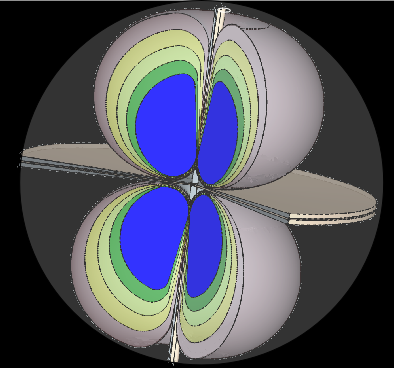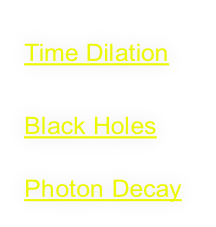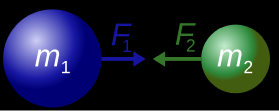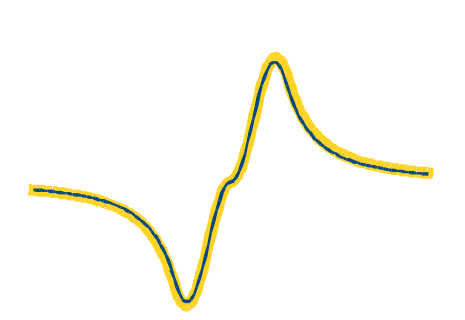








What is the difference between a meteor and a photon falling to the Earth?
The meteor travels faster, the further it falls, the photon does not. The meteor is easy to understand. It has linear mass and for the sake of argument, is not spinning. Gravitational attraction between the meteor and the Earth exerts a force that causes them to accelerate towards each other. The force is equal between planet and meteor which is why the Earth does not appear to move. The classical expression for this force is:
F = G
m1 m2
R2
There are problems with this expression. It assumes the objects are static and have no dimension, both of which are wrong. This is explored in Gravitational Attraction.








The Ejecta:
The spinning matter is gyroscopically stable. It spins so fast, it would be internally unstable and rip itself apart if it were not for the huge pressure preventing this. It cannot collapse into the more compact triangular form as the contra spin from the neighbours prevents this. This is also true for the layers above and below.
Everything that falls into a black hole is lost forever, right? Quasars are the brightest objects in the universe and they are super-massive black holes (Astronomers just have two names for the same thing). They say that all that energy comes from the surface? How so? Material falls in on the galactic equator, how does it ‘magically’ get to the North and South pole?
Let’s just imagine that it falls in. How does it get out. The Quasar tells us; from the poles.
So we need to imagine a mechanism where this can happen. The material cannot be ejected, it would have to be travelling at greater than the speed of light. So it has to be pushed.

A slice through the polar column (looking down)
Matter falls into the black hole at the galactic equator (white arrows). The matter contributes two components to the black hole: Its rotational momentum and its mass (bearing in mind that only light fell into it). If matter were to fall directly into the black hole, for instance, material from outside its own galaxy, it would not contribute to its rotational momentum and would have to be pushed out (eventually; see below). The matter must be a superfluid but unlike in Bose–Einstein condensates where there is no free energy to share, the neighbouring matter is already fully saturated. All of the matter is in the same state and only its position within the black hole I suspect determines its spin magnitude if it is variable (it may not be).

The matter has nowhere else to go once it reaches the centre of the black hole. Now it is picked up by either the North or South Toroidal Motors (Blue zone). These are the twin hearts of the black hole and where almost all of its rotational momentum is stored as they spin about the poles (blue arrows). The matter circulates as shown by the black arrows (hmm). Note that the total rotational momentum of this motion is zero.
The motors compress and order a small amount of matter along the axis of the poles (red line). Some is directed North and some South in equal measure. This material, (see insert The Ejecta above), again has no rotational inertia as the spins are balanced but there may be some residual inertia from the motors giving the column a tiny amount of corkscrew.




What is light?
Photons are light. It may be X rays, Gamma rays or that of any other frequency. Light can be classified as visible or invisible but it is all light. The boring term but more informative label is electromagnetic radiation as this describes its properties (or at least some of them). This doesn’t really tell us what a photon is, see photon decay for another attempt.
What of the photon?
In order to be captured by the planet, the photon has to gain energy just as the falling mass does. It cannot increase it’s velocity so it changes colour, it gets slightly ‘hotter’. But where does it get this energy from? The atoms that make up the planet must surrender some of their energy to the photon, so the atoms ‘slow down’. Scientists call this time dilation, but it isn’t. It is the atoms that change, not time, it is just that we use the atom to measure time, but the clock is now running slow. photon decay.
What of the photon?
The early view of the universe being infinite was dispensed with using, as one of the the arguments, that the sky would be white all over as there would be photons from every angle of space falling upon us. It would be worse than this for not only would white light be visible but the invisible, such as X-Ray and Gamma rays. They would rain down on us. The universe would be sterile for no life as we know it could survive this.
So light has to cool down. We know this already as we know the background ‘temperature’ of the universe (energy density). It is very cold, a few degrees above absolute zero.
So this early view would fail if the photon ‘cooled’ over time. See everything decays. If the photon has an infinite time to decay (until it falls into a black hole), then it will be invisible to us. The cosmic microwave background would be the ‘last gasp’ of the photon on its decline, the last time it is able to interact with the universe, resonating with hydrogen, until it is re-energised by its next black hole encounter.
But what is decaying in the photon?
I want to call it spin but that would be misleading. Using the earth as an analogy, it spins once a day but it is blue (mostly). The blue is also spin. As water molecules emit reflected light from the sun we can see the internal activity of our planet. We can’t see the internal activity of a photon but we know that it carries energy within it.









OK, this is a difficult one, so let’s eat the elephant slowly.
What does light do?
Light is the most obvious information transfer system for the universe (maybe, the only one). The other fundamental forces do the same but do not affect us so obviously (we don’t float off into space, we can’t walk through walls and we don’t get stuck to things we touch: useful but not obvious ways of transferring information).
The currency for this information exchange is energy.
Light is energy.
we can note that as only light can pass through the event horizon of a black hole, all falling objects have to convert to light as they approach it. What appears on the other side is another thing entirely, as discussed in Black Hole.
What is light?
Light is the currency of the universe. All transactions are carried out by way of exchanging light. It is the universe’s banking system. The intermediary for this transaction is momentum. This is true for all transactions whether they are at the photon, electron or atomic level. The photon can be considered the single coin, the electron, the purse and the atom, a bank vault (this analogy breaks down a little as there is no minimum denomination. It goes all the way down to zero and if you are not careful during your transactions you may donate energy to the photon when expecting to gain some).
